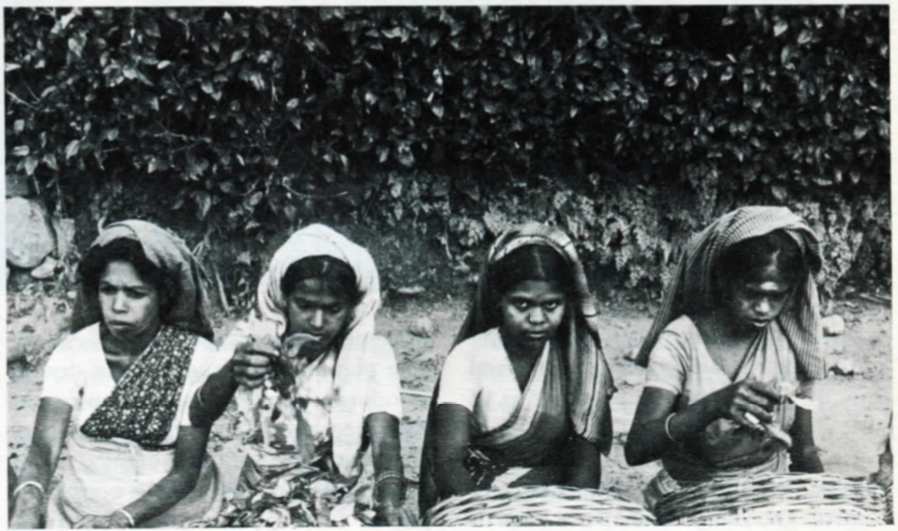A Report from South India
Having had the common experience of growing up female in rural India, we had been brought up to view our bodies with suspicion and contempt, and this had given us a poor self-image. Having never understood the way our bodies functioned, we were ashamed of and feared its functions. Learning about our bodies has helped us develop self-respect and has given us a sense of power over our lives, and the confidence to challenge and change things around us. This is why our first step in working with other rural women was to be about Women and Health, and this, we believed, could eventually encourage women to play an active role in their communities and work to change their oppressed situation.

The women who constitute the Rural Women's Social Education Centre belong to the villages of Chingleput in Tamilnadu, South India. With the exception of just one, all of them belong to the harijan or untouchable castes, which is on the lowest rung of the traditional caste hierarchy. Each of them works as an animator in her own village, and is trained to perform a multitude of functions: health care, health education and advocacy, literacy
teaching and organising women. A doctor and a coordinator assist them in their work.
The animators provide basic health care to the villagers, with special attention to women. They examine and advise pregnant women and lactating mothers, monitor the growth of children and arrange for their immunisation regularly. They administer simple home remedies as far as possible. They have teamed-up with the traditional village midwife to conduct deliveries hygienically. They have helped village women understand their health problems and participate in their own healing, rather than being 'Messiahs' who can cure all illnesses.
The animators have set up a women's centre in each of their villages. It serves as a meeting place for women who get together late in the evenings, once the endless chores of the day are over. It is also a place to meet, talk, relax, discuss and learn. One evening a week is set aside for learning about health related problems that concern women. They have learnt about how their bodies function, about menstruation, pregnancy, child birth and birth control. They have discussed for hours the validity of many of the myths and taboos surrounding menstruation and child birth that still prevail.
Discussions on malnourishment have led to talking about the need for higher wages for the difficult agricultural work they do, since what they now earn can scarcely feed one person adequately. When we examined causes of diarrhea and dysentery the common killers of children under five, it became clear that their prevention is impossible without protected drinking water. This meant petitioning the authorities and we had to learn about procedures for this as well.
Another oft-discussed subject is birth control. The village women are keen to practise birth control and eager for information. One of their major problems is the right to choose a method of their choice. Contraception services are free in our hospitals, and in their anxiety to utilise their resources optimally, the hospital tend to stipulate who can avail of what to the extent that the woman concerned has hardly a say in the matter. The women from many of our villages brought this to the notice of higher authorities. Health issues are thus inextricably linked to the social, economic and political issues of the milieu, and challenging the one means challenging the whole.
Apat from the health related discussions there are also other meetings through which the women are participating in a process of developing their critical conciousness about the structures that oppress them. Role plays that portray the reality of their existence are a great favourite. After a role play on, for example, the double standards applying to women in the village community, or the way the poor are treated by the bureaucracy, or the way landlords use their economic power over poor women from the Harijan castes from sexual exploitation, the women's centre comes alive with voices of women. Everyone participates in talking about the characters portrayed in the roleplays and eventually comes to see how it is related to her own life. At times the animator reads to the women stories, anecdotes and case studies depicting lives of poor women like them or instances where women have actively confronted the system and tried to change it.
The women's centres have helped in the consolidation of women's groups in these villages and led to the creation of women's sanghams (associations) with the members paying a small membership fee of 50 paisa. This amount subsidizes the cost of medicine dispensed and a part of it is set aside as savings. The women's sanghams are taking an active part in the affairs of their respective villages. They have organised to demand higher wages in some villages, with success. Their untiring efforts to secure drinking water taps was rewarded in one village. They are alert, and take preventive measures against epidemics. They act as a pressure group to secure what is rightfully due to them from the powers that be.
Women from different village sanghams meet in workshops organised thrice a year. Each of these wokshops has a particular theme. A wide range of themes have been taken up so far: political parties and their ideologies, Panchayat (village council) elections, development plans of the government, group dynamics, public speaking, problem solving techniques, to mention a few.
They say:..our beginning to relate to our society through the women's movement has given a central unity to our lives; we are no longer drifting, relating passively to life; rather we are attempting through an intensive relationship to society to affect history, to act instead.

